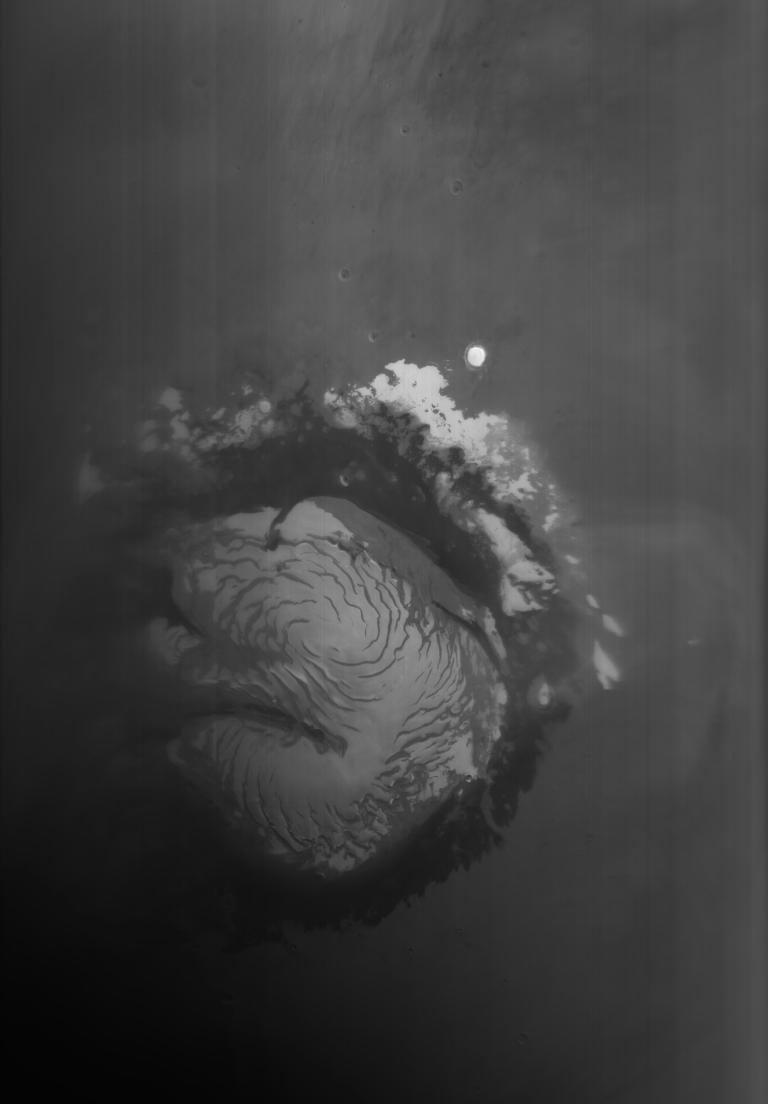

In
the book “Journey to the Earth’s Interior,” ( 1913 ) Marshall B. Gardner
gathers together testimony relating to the sightings of a gleam or glint of
light emanating from the North Polar area of Mars, which was observed by the
astronomers Lowell, Mitchell and Green, all during different years and and from
different locations. Gardner makes a strong case in favor of the
hypothesis that the light originates from the interior of Mars, from the planet’s
inner sun.
We will present the pertinent sections of Gardner’s book below for reference.
The reader should realize that, although this information is older, it is
especially reliable as there was little censorship in those times. For example,
Percivell Lowell, who was one source of information, was independently wealthy,
a Boston brahmin, and had to offer explanations to no man.
Professor Lowell records:
"Meanwhile an interesting phenomenon occured in the cap on June 7 ( this
was in 1894 ). On that morning at about a quarter to six (or, more precisely, on
June 8, 1 hour, 17 minutes, G. M. T.), as I was watching the planet, I saw
suddenly two points like stars flash out in the midst of the polar cap.
Dazzlingly bright upon the duller white background of the snow, these stars
shone for a few moments and then slowly disappeared. The seeing at the time was
very good.” Of interest is the fact that professor Lowell points out two
separate, star-point flashes, lasting but moments.
Gardner from page 83: “In this same part of his book, " Mars ",
Lowell speaks of a fellow observer, Mr. Douglass, who detected " rifts
" in the cap-- which sounds suspiciously as if this observer has seen
clouds in the interior of the planet passing across the face of the polar
opening. And Lowell adds, ‘ On June 13 I noticed that behind the bright points
the snow ( he calls it ) fell off shaded to this rift ‘ which again sounds as
if clouds were gathering near the bright spots. He continues:
‘Bright spots continued to be seen at various points to the westward round
the cap ... Throughout these days the cap was wont to appear shaded on the
terminator side.’ The last sentence surely suggests that cloud formations were
coming into the field of view and that wherever they thinned the bright spots
from the central sun could be seen between them.”
The reader will notice the image above of the floor of the depression which sits
at the North Pole of Mars. There is definitely a crater-like depression,
at first glance,
it does not seem to funnel directly into any openings which lead to the hollow
cavity of the planet. However, Lowell’s testimony stressed that two separate
glints of light were seen, and the floor of the depression does show two rather
large crevices. Could it be that the flash points of light reported by the
astronomers above are glimpses of the inner sun shining through these crevices?
The image below is a closeup of a
point along one of the crevices shown in the image above. The reader can see
that there are openings and
that a certain depth or penetration is involved.
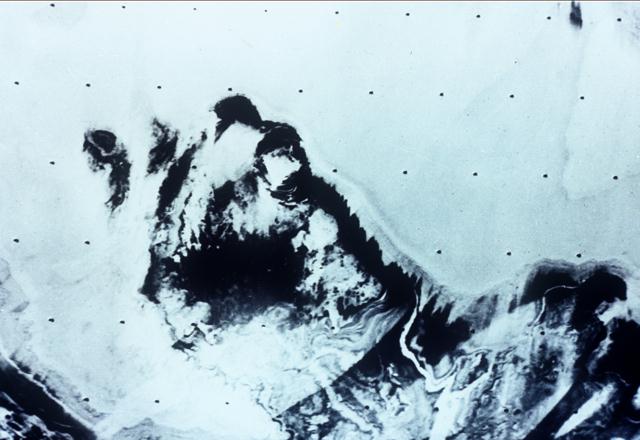
In this regard,
Joseph H. Cater wrote this
writer in a personal letter that "With no
'large'
openings, Mars has to have a relatively thin shell." The interior sun of
other planets, such as the Earth, can ventilate through these openings. When aggregates of photons build up within the Earth's inner cavity due to sunspot activity,
such particles spurt out with such force that the photon aggregates disintegrate
into their constituent light in the process and form the aurora. Since the thin
shell of Mars allows the radiations of its inner sun to radiate back outward,
significant polar openings are not necessary."
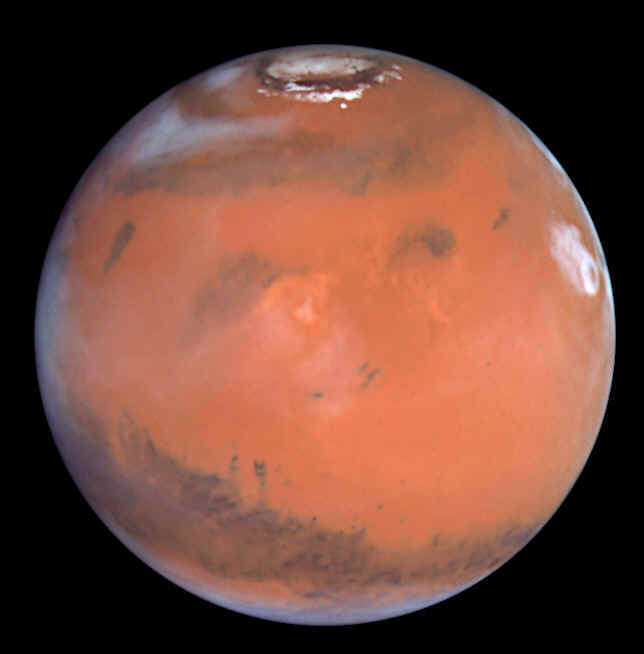
The
above is a photograph of Mars provided by the Hubble Space telescope. The
central depression/crater is visible right at the Martian North Pole. It is
about 10% of the diameter of the entire planet, a huge crater. It is deep,
shockingly deep. And the reader will note that it is practically empty, as even
some orangish ground can be seen at the bottom along with some residual ice.
This tells us that the above picture is a picture of the Northern Martian
hemisphere in the summer, as the “ ice cap “ has largely melted and the
crater is empty.
A polar depression such as the one which we see at the top of Mars, is simply a
natural result of the planet’s formative process. The amount of centrifugal
force which would have been necessary to impose the almost perfect roundness
upon the exterior surface of the planet would have surely opened up a cavity
within. Matter would have been drawn towards the equator, making the equatorial
region thicker, leaving the crust at the axial points thin- or even ruptured- at
the top.
The traditional explanation that the polar depressions on Mars ( and other
planets ) are actually huge impact craters is not tenable. An impact crater
would have a depth which corresponds to its diameter, which this one doesn't
have. An impact capable of producing a depression which is a significant
percentage of a planet's diameter would break the planet asunder. And how do we
explain the fact that Mars has two similar craters at the polar points, nearly
the exact opposite of each other?
The reader will notice that the photo below of the SOUTHERN polar area of Mars,
culled and enhanced by Liz Edwards of Iwonderproductions, also shows an opening.
There is even some geometry associated with the opening in this picture.
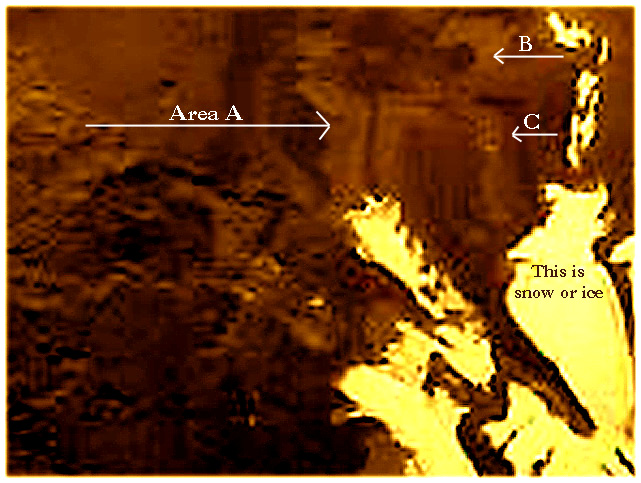
The
traditional idea that the public has in relation to the ice caps is that they
are rather thick and that they accumulate during the Martian winters and melt
during the Martian summers. However, it can be seen that, in the first picture,
the northern depression/crater is empty. This indicates that the ice had melted,
which suggests that the crater does not fill to the brim with accumulated ice in
the first place. How could it be that such a tremendous quantity of ice could
accumulate every winter, only to melt away again during the summer and leave the
crater empty? How much water would be involved to accumulate in a crater which
is hundreds of miles wide and many, many miles deep? This would be something
akin to having the entire ice sheet on Antartica build up and melt every year.
Where would such an amount of water/ice come from? Mars is presented to us as a
mostly dry planet, supposedly with no rivers or lakes. The Martian atmosphere is
said to have only 2% of the density of the Earth’s atmosphere, so it could not
be laden with much moisture given this model. Even on the Earth, a planet which
is 2/3 covered with water, we cannot imagine such a phenomenal amount of
accumulation and melting taking place over the span of a year.
If the depression were largely filled with ice which melts, we would have to
witness the water draining out and sloshing here and there
in wide rivers. Astronomers have
ventured the explanation that the water may be quickly absorbed by cracks and
crevices, such that we simply have never observed it drain, but that would be a
lot of water to disappear unperceived. Is such
an explanation reasonable?
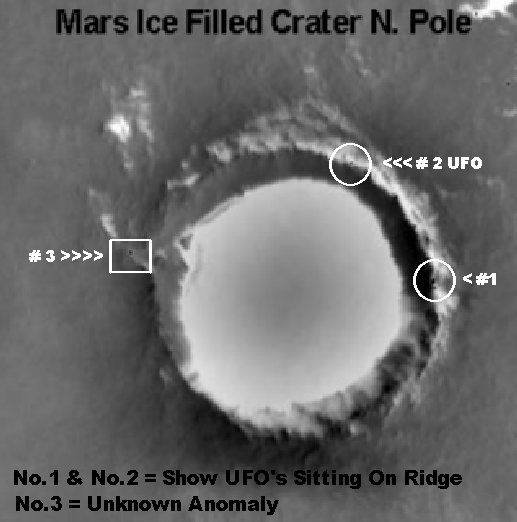
The
above photograph suggests that the ice- were it ice- is relatively shallow in
the depression, only coming to the brim on one side, and way below the brim on
the other. Other photos, however, show the depression full to the brim on all
sides. We cannot accept that it is accumulated ice which is responsible for this,
for the reasons which we have just gone over.
Therefore, we can conclude that the polar depression is principally filled by
mist and cloud cover which accumulates every winter. The clouds fill in the polar
depression and stay put in
it. This fits in well with Gardner’s theory
that it was cloud cover which
was actually seen at the pole. And where does thick,
heavy cloud cover come from on a planet whose atmosphere is only 2% of that of
Earth’s? The traditional, solid-planet model does not explain this cloud
phenomenon in any suitable way.
The Hollow Planet Theory offers a tenable explanation; that the clouds result
from the warmer, humid atmosphere from the interior of the planet in contact with the
colder, outer atmosphere. Although there is no gaping hole seen in any NASA
images of Mars, the pictures at the top of the page shows crevices
that give way to caves and
openings that can allow the passage of
humid air and clouds from within the planet. The Martian polar depression, then,
is the threshold of an opening to the interior of the planet.
Thus common notions about Mars do not correspond to observations, which is why
Joseph H. Cater insists on a thick Martian atmosphere in his book The Awesome
Life Force:
“According to NASA, recent calculations have shown that the Martian
atmosphere has only about one percent the density of the earth's. This
contradicts other findings concerning cloud formations. Dense and very extensive
clouds are often detected on Mars. Pictures of the volcano Olympus Mons have
shown clouds hovering close to the summit of the mountain, which is supposed to
rise 15 miles above the surrounding countryside. It is claimed that clouds are
often found at an elevation of 90,000 feet! This is much higher than any water
vapor and ice clouds found on the earth. The fact that they move shows that the
air is sufficiently dense at such altitudes to produce winds capable of moving
clouds. This indicates that Mars actually has an atmosphere denser than that of
earth."
"Another factor that confutes the claim of a thin atmosphere is the tremendous
dust storms that often occur. Some of them dwarf any that have ever been
experienced here on earth. The experts try to surmount this difficulty by
assuming wind velocities of over 300 miles per hour. How sustained wind
velocities of this magnitude could be achieved has never been made clear. In
addition, extensive areas of fine dust necessary to produce such a condition
could not exist in an atmosphere as thin as that which has been attributed to
Mars.”

In
the picture above, we can see clouds fingering their way through what appear to
be mountains or maybe even eroded pyramids. Even though these mountains do not
have the height of Olympus Mons, these clouds do not fit in with the mainstream
understandings of the Martian atmosphere.
Such an atmosphere would have to be deep given the fact that clouds are observed
at 90,000 feet. What to speak of the fact that the planet reflects light at the
end of the spectrum, red. Even the Earth’s atmosphere only reflects light
within the blue spectrum into outer space, what to speak of a planet whose
atmosphere is deep enough to bring light to the reddish end of the spectrum.
Again, a Martian atmosphere lends a lot of support to the idea that cloud cover
obscured the flashes of light observed by the astronomers above.
The NASA pictures, together with the evidence gathered by Marshall Gardner and the insights of Joseph H. Cater, should be sufficient to give the reader a different perpective on the matter of polar openings leading to hollow planets. Hopefully they have.